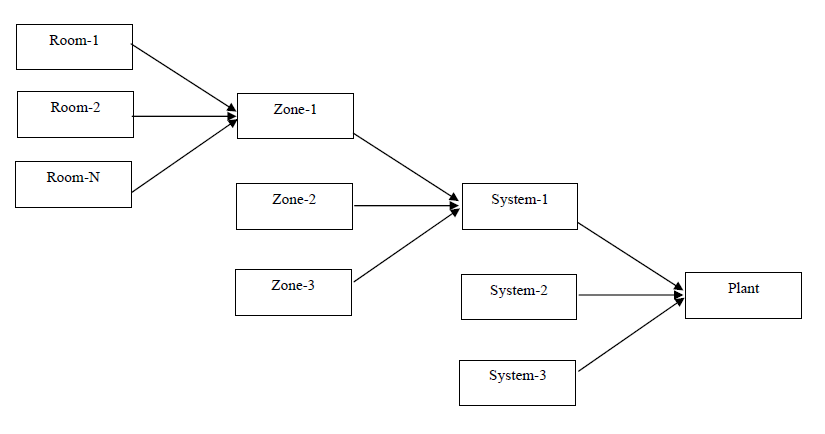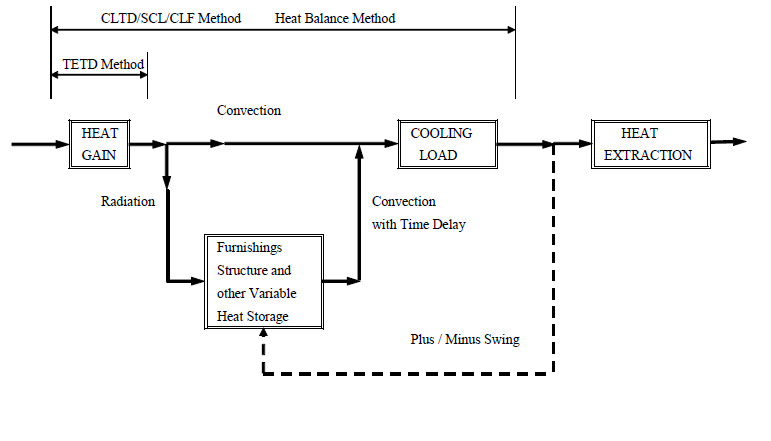Summer Cooling Loads
Room: Calculate the peak cooling loads (a) Sensible (b) Latent
Zone: Simultaneous peak of rooms + zone loads (terminal fans, recirculation air, etc.)
System: Simultaneous peak of zones + system loads (outdoor air, fans, ductwork)
Plant: Simultaneous peak of systems

| Room | (a) Sensible: exterior (roofs, walls, windows, infiltration), interior (people, equipments, lights) |
| (b) Latent: (infiltration, people, equipments) |
Zone: used to control conditions in several rooms based on control (ex. thermostat) in one of the rooms
| System: | (a) Sensible: (outdoor air, fans, recirculate air,ductwork, equipments etc.) |
| (b) Latent: (outdoor air,recirculate air) |
| Plant: | (a) Sensible Cooling (Chillers, Cooling Towers, Pumps, etc.) |
| (b) Heating (Boilers, Heat Exchangers, Pumps, etc.) |




Vent
Zone-1 hourly loads = Hourly loads of Room-1 + Room-2 + ------------ + Room-N in Zone-1
Zone-2 hourly loads = Hourly loads of Room-1 + Room-2 + ------------ + Room-N in Zone-2
System-1 hourly loads = Hourly loads of Zone-1 + Zone-2 + ------------ + Zone-N in System-1
System-2 hourly loads = Hourly loads of Zone-1 + Zone-2 + ------------ + Zone-N in System-2
Plant-1 hourly loads = Hourly loads of System-1 + System-2 + ------------ + System-N in Plant-1
Plant-2 hourly loads = Hourly loads of System-1 + System-2 + ------------ + System-N in Plant-2
Room Loads

- Calculate room total SHG and LHG for each hour (typically 6am-8pm of a typical day, usually 21st day of month, for the summer months of May to October.
- Select the peak maximum SHG for each room and the corresponding LHG, by month and hour of peak.
- Select the supply air temperature from system to rooms (typically 55oF).
- Calculate supply air quantities for each room based on its peak SHG.
- Check supply air quantities with codes and standards. Increase supply quantities and reset air supply temperature accordingly.
- Calculate humidity ratio of supply air to offset the room LHG.
Cooling Loads Principle (summarized from ASHRAE)
Space heat gain is the rate BTU/Hr of which heat entering the space or room (external heat gain), and is generated within the space (internal heat gain) at a given instant hours.
Heat gain is classified by
1) Mode in which it enters the space
2) Whether it is in sensible or latent
Mode of heat gain
- Direct solar radiation through transparent surface (glass windows and skylights).
- Heat conduction through wall and roof due to
- Inside and outside temperature difference.
- Incident solar radiation on outside surface.
- Heat conduction through interior partition, ceiling, and floor due to temperature difference on two side of the structure.
- Heat generated within the space by
- Occupants (sensible and latent)
- Lights (sensible only)
- Receptacles (sensible only and Equipment (sensible and latent)
- Energy transfer due to the outdoor air
- Infiltration (sensible and latent)
- Ventilation (sensible and latent)
Sensible and Latent Heat Gain
Sensible heat gain SHG is added to the conditional space by conduction, convection and radiation. Usually there is a time lag form when the heat is generated from its source, to when the heat affects the temperature and condition of the air in space.
Latent heat gain LHG occurs when moisture (water vapor) is added to the air in the space. Example vapor emitted from occupants and equipment (ex. kitchen processes). Latent heat gain is usually an instantaneous (no time lag) load. The air in the space absorbs the vapor as the vapor is generated by the source. To maintain a constant humidity ratio in the space, water vapor gain in the space must removed at the same rate it enters the space. This is usually done by cooling the supply air moisture content to a value below that of the required space moisture content so that it offsets the space LHG. Systems and Plants have to be designed to remove total heat gain THG (Sensible heat gain SHG + Latent heat gain LHG).
Space Cooling Loads
Space Cooling Load is the rate at which heat must be removed from the space to maintain constant required space air temperature and moisture content (relative humidity). The sum of all space instantaneous heat generation rates at any given time is not necessarily the peak zone or system heat gain per hour since the cooling load per hour of are different and they peak at different times.
Radiant Heat Gain
Radiant heat gain is an example of heat entering the space that is not immediately converted into a cooling load. Radiant heat energy must first be absorbed by the surfaces that enclose the space (Walls, Floors, Ceilings, Partitions) and the objects in space (Furniture etc.). As the surfaces and objects become warmer than the air in space, the heat from the surfaces and objects are transferred to the space air by conduction and convection, and thereby increasing the space air temperature.
The composite heat storage capacity of these surfaces and objects determine the rate at which the temperature of the surfaces and objects increase due to incident radiant heat energy. Thermal storage effect is critically important in differentiating between instantaneous heat gain for a space and its corresponding cooling load.
Space Heat Extraction Rate
The rate at which heat is removed from a conditioned space must be continuously and exactly equal to the space cooling load in order to maintain the required space temperature. This is not a practical operating condition for automatic control systems and HVAC equipment. Damage can occur to the HVAC equipment if it is continuously cycling on and off.
In conjunction with the intermittent operating of the HVAC cooling equipment, the control system settings and operation usually permit a small cycling variation or swing in room temperature. For an on-off control of a room air conditioner, the thermostat set point can be 75oF. The AC unit goes off when the space temp drops below 72oF. The space temperature will now start to rise because there is no cooling. When the space temperature goes above 78oF the AC unit comes on again.
Therefore a proper simulation of the control system and HVAC equipment give a more realistic value of heat energy removal over a time period. The concept is important for energy estimating and it is not necessary for calculating peak cooling loads for HVAC equipment selection.

Cooling Coil Loads
The rate at which energy is removed at a cooling coil (that serves one or more conditioned space equals to the sum of the instantaneous heat gain adjusted for thermal time lag due to heat absorption, storage and transfer properties of various surface and object in space.
Instantaneous space sensible load
Instantaneous space sensible load is the rate of heat flow into the space air mass. This quantity sometimes called space cooling load. The total cooling load, which also accounts for room latent heat gain and ventilation sensible and latent loads, is extracted at the system level by the cooling coil.
Instantaneous space sensible load differs from space sensible heat gain. Space sensible heat gain contains a radiation heat gain component that passes entirely through the air mass (without affecting the air mass) and absorbed by the room boundary surfaces (wall, ceiling, floor) and other objects in the room.
Instantaneous space sensible load is entirely convective. Even loads from internal equipment, light and equipment enter the air by convection from the boundary surfaces of the room, and the objects in the room that has absorbed by radiation heat energy falling onto their surfaces.

For equilibrium conditions, the Instantaneous space sensible load must be matched or offset by the heat removal rate of the air-condition equipment. The two most widely used methods for calculating Instantaneous space sensible load are;
1) Heat balance method (Conduction Transfer Function)
2) Weighting factor method (Response Factor)
Weighting and response factor, and conduction transfer functions are all based on based on the same mathematic analysis (Discrete convolution series). However each method represents different concept. Weighting factor (also called room response factor) is used in the weighting factor method to calculate space instantaneous sensible load components from corresponding heat gain components. Conduction transfer functions, on the other hand, refer to conductive heat transfer through wall, floor and roof, are used to calculate the transmission component of heat gain.
Note: for the weighting factor or response factor and the heat balance method (conduction transfer functions) are used to calculate transmission heat gains. The main difference between the two methods is the precedence used to calculate the subsequent internal heat transfer to the room. Experience from using the two methods has indicated approximate same results.
Transfer functions
These coefficients related an output function at a given time to the value of one or more driving functions at a given time, and at a set-point period immediately preceding.
Conduction Transfer Functions (CTF) is the same as thermal response factor used for calculate wall and roof heat conduction. Room Transfer Function (RTF) is the weighting factor used for calculate cooling load component
Space Cooling Loads Calculation Methods
There are basically 4 methods for cooling load calculations;
- Total Equivalent Temperature Differential method (TETD), ASHRAE 1972 Handbook.
- Transfer Function method (TF), ASHRAE 1976 Handbook
- Cooling Loads Factor method (CLTD/SCL/CLF) ASHRAE 1989 Handbook
- Heat Balance Method - ASHRAE 2001 Handbook
The calculation of cooling loads for space involves calculating surface by surface conductive, convective and radiation heat balance for each room surface, and a convective heat balance for the room air. To calculate space cooling loads directly by heat balance procedure requires a laborious solution of energy balance equations, which involving space air, surrounding wall, window, roof, skylight, infiltration air, ventilation air and internal heat energy sources.
Total Equivalent Temperature Differential method (TETD)
Total Equivalent Temperature Differential method (TETD), the response factor technique was used with a number of representative wall and roof composite assembly structure from which data were derived to calculate Total Equivalent Temperature Differential (TETD) values as function of Sol-Air temperature. Sol-Air temp is the outside surface temp of a wall or roof. It depends on the outdoor DB temp, direct solar radiation on the surface, and the surface roughness, color, reflectivity and absorbtivity properties. Dark colors absorb more heat. Smooth surfaces reflect more heat.
Various component of space heat gain are calculated using associated Total Equivalent Temperature Differential (TETD) values, and the results are added to internal heat gain elements to get an instantaneous total rate of space heat gain. This space heat gain is converted to an instantaneous total cooling loads by the time averaging method (TA). Time averaging method (TA) averages the radiation portion of the heat gain load components for the current hour, with respect to the values from an appropriated period of immediately preceding hours.
Transfer function method (TF)
Transfer function method (TF) applied a series of Weighting Factors (WF) or conduction transfer functions (CTF) coefficients to the various exterior opaque surfaces and to the differences between Sol-Air temperature and inside space temperature to determine heat gain with appropriate reflection of thermal inertia of such surfaces.
Solar heat gain through glass and various form of internal heat gain are calculated directly for the load hours of interest. Transfer function method (TF) applied a second series of weighting factor (WF) or coefficients of room transfer function (RTF), to heat gain and cooling load values from all load elements, accounts for thermal storage effect in converting heat gain to cooling load.
Both evaluation series consider data from several operating hours. Room transfer function (RTF) coefficients relate specially to space or room geometry, configuration, mass and other characteristic of space, to reflect weighted variation thermal storage effect.
Cooling Loads Factor method (CLTD/SCL/CLF)
In the late 1970's, ASHRAE sponsored research to compare Total Equivalent Temperature Differential method (TETD), Time averaging method (TA), and Transfer function method (TF). As part of the work, data obtained by using Transfer function method (TF) on a group application considered representative of typical buildings, were then used to generate Cooling Load Temperature Differential method (CLTD) data, for direct one step calculation of cooling load from conduction heat gain through sun-lit wall and roof, and glass exposures.
Although it is called the CLF method, it consists of Cooling Load Temperature Difference through walls and roofs (CLTD), Solar Cooling Load through glass (SCL) and Cooling Load Factors (diversity and time delays) for internal sources such as people, lights, equipment (CLF). Cooling Loads Temperature Differential (CLTD), Solar Cooling Loads (SCL) and Cooling Loads Factor (CLF) includes the effect of:
- Time lag in conduction heat gain through exterior opaque surfaces
- Time delay by thermal storage in converting radiant heat gain to cooling load.
This simplification allows cooling loads to be calculated annually. The results are consistent with the results from Transfer Function method (TF).
